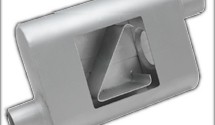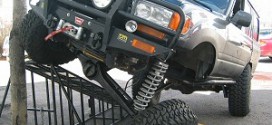How To: Adjusting Camber on your Axle with Ingalls Engineering Alignment Shims

With the upgraded axle assemblies and Rubicon Express Extreme-Duty Lift kit installed on Project Over Easy, it was time to turn our attention to a proper alignment. The entire suspension for our Jeep Scrambler has been rebuilt, replaced or upgraded in some manner, which means our steering alignment was really off kilter. During a few quick test drives, the Scrambler tracked about as straight as a three-legged, blind dog named Lucky – we needed the help of a proper alignment shop. While we could have ponied-up for a fancy alignment at an off-road specialist, we’ve elected to go the tried-and-true route of a lifetime alignment at our local Firestone. We were lucky enough to find a local Firestone with a great deal of patience for our repeated trips to their shop, required after each tweak to the suspension. Through their help, we got the suspension nearly dialed-in to the factory specifications with one exception, a nagging negative camber issue that was just outside of the factory setting.
 Solid Axle Camber Adjustment Solid Axle Camber Adjustment
How in the world do you address camber issues on live axles? Caster and toe are easily adjusted but camber adjustments take a bit more thought. Lucky for us and any of you out there needing to adjust camber on your solid front axles, Ingalls Engineering (Ingalls Engineering) has a solution. Ingalls Engineering is a Colorado-based, manufacturer of performance, suspension, steering and alignment components as well as special tools that may be required for work in those same areas. Ingalls has a clever solution to live axle camber issues worthy of display in a CD jewel-case. In fact, their camber shims for the Project Over Easy Scrambler’s Dana 30 axle are exactly the same diameter of a standard CD/DVD and they ship in CD-like packaging.
| Installation – Ingalls Camber Shims |
| Time: |
1 Day |
| Tools Needed: |
Dana hub socket, standard wrenches, sockets, ratchet, drain pan, jack, jack-stand, rubber mallet, wheel bearing grease, brake fluid, brake bleeder (or patient friend with strong legs) |
| Difficulty: |
 |
|
Installation
  Reviewing the components – The Ingalls Engineering Camber Shims, part # 26126, are machined from billet 6061-T6 aluminum, a material with a yield strength of 40,000 psi and a tensile strength of 45,000 psi. These components are machined to exact tolerances of diameter, bolt spacing and most importantly, shim thickness by degree. The camber shims are designed to be installed between the steering knuckle and all outer hub/brake components. Reviewing the components – The Ingalls Engineering Camber Shims, part # 26126, are machined from billet 6061-T6 aluminum, a material with a yield strength of 40,000 psi and a tensile strength of 45,000 psi. These components are machined to exact tolerances of diameter, bolt spacing and most importantly, shim thickness by degree. The camber shims are designed to be installed between the steering knuckle and all outer hub/brake components.
Ingalls carries shims for knuckles with a 6 bolt x 4″ diameter bolt circle like Dana 30s and 44s as well as larger axles with 8 bolt x 4″ diameter bolt circle. Ingalls Engineering is also considering a larger diameter 5 bolt shim for the Ford Dana 44 if interest proves positive.
|
| Preparing to install – In order to get to the mounting location for the Ingalls Engineering Camber Shims, it is necessary to remove and set-aside all outer hub and brake components: Move vehicle to flat, level surface Apply parking brake and/or chalk wheels Loosen lug nuts |
J ack-up vehicle Safely position vehicle on jack-stand Remove wheel (Note: We always place wheel on its side under the vehicle for an added degree of safety.) ack-up vehicle Safely position vehicle on jack-stand Remove wheel (Note: We always place wheel on its side under the vehicle for an added degree of safety.) |
    Unbolt brake caliper from knuckle and safely hang within wheel well (Note: It is not necessary to remove caliper from brake line but it is important that the caliper be securely supported and not be hung by the brake line.) Remove brake rotor and hub assembly Remove brake rotor backing plate Unbolt brake caliper from knuckle and safely hang within wheel well (Note: It is not necessary to remove caliper from brake line but it is important that the caliper be securely supported and not be hung by the brake line.) Remove brake rotor and hub assembly Remove brake rotor backing plate |
  Loosen hub bolts Remove outer hub assembly Loosen center hub nut Loosen hub bolts Remove outer hub assembly Loosen center hub nut |
| “Measure Twice, Cut Once” – Important: You are now ready to begin the installation. It is critical to know the amount of camber degrees that must be adjusted for on each side of your vehicle. Make sure that you get that right for each side and that you remember whether to clock each side for a negative or positive camber adjustment. While this is a relatively simple procedure, careful attention to detail in the clocking of the shims will reduce the need to make any further camber adjustments. Thanks to our friends at Firestone, we knew the amount of camber that we needed to adjust for on each side of Project Easy. We were ready to install. |
Camber Shim Clocking – The Ingalls Engineering 6 Bolt Knuckle Camber Shim, Part # 26126, was selected for our Dana 30 axles. These 4” diameter shims vary in thickness from one side to the other, providing a degreed incline to address either positive or negative camber issues. Each shim provides an adjustment range adjustment range of ±1/8° to ±1-1/2°. The below image shows how the shim can be rotated to provide the needed camber adjustment.
• For positive camber adjustment, clock the desired degree setting to the 12 o’clock position.
• For negative camber adjustment, clock the desired degree setting to the 6 o’clock position. |
Choose the best fit setting – While we would love to have a perfect 0 degrees of camber on each side, there is not an exact match for 0.7 and 0.6 degrees of negative camber. We elected to have the best fit for each side by selecting the 5/8° setting on the Ingalls Engineering Camber Shims. This gave us a camber adjustment of 0.625 degrees on each side resulting in:
• 0.075 degrees of negative camber on the driver’s side
• 0.025 degrees of positive camber on the passenger side
Since the factory tolerance allows for ±0.5 degrees of camber on each side or a sum total of ±1.0 degrees from side to side, the Ingalls Engineering Camber Shims enabled us to achieve a total of 0.1 degrees of camber across the axle assemble. This is about as close to 0 degrees camber as you can get. |
 Putting it all back together – Installation is really as simple as reversing the disassembly. You’ve done the tricky part of clocking the shims. Now, put it all back together taking special care to torque all bolts to the proper setting and allowing for the proper run-out settings on the wheel bearing. While you should not have had to open the brake caliper hydraulics to the atmosphere, a quick brake bleed is always a good safety measure. Putting it all back together – Installation is really as simple as reversing the disassembly. You’ve done the tricky part of clocking the shims. Now, put it all back together taking special care to torque all bolts to the proper setting and allowing for the proper run-out settings on the wheel bearing. While you should not have had to open the brake caliper hydraulics to the atmosphere, a quick brake bleed is always a good safety measure. |
|
|
As you can see, the Scrambler is now fully within the specified alignment ranges for Camber, Caster and Toe. Yes, we could have been a little more aggressive with the clocking of the camber shims on the left side but completely nailed the clocking on the right side. We’ll revisit the left side later to try to dial it into 0.0° but are completely satisfied with the results of the Ingalls Engineering Alignment Shims.
 4x4Review Off Road Magazine
4x4Review Off Road Magazine



